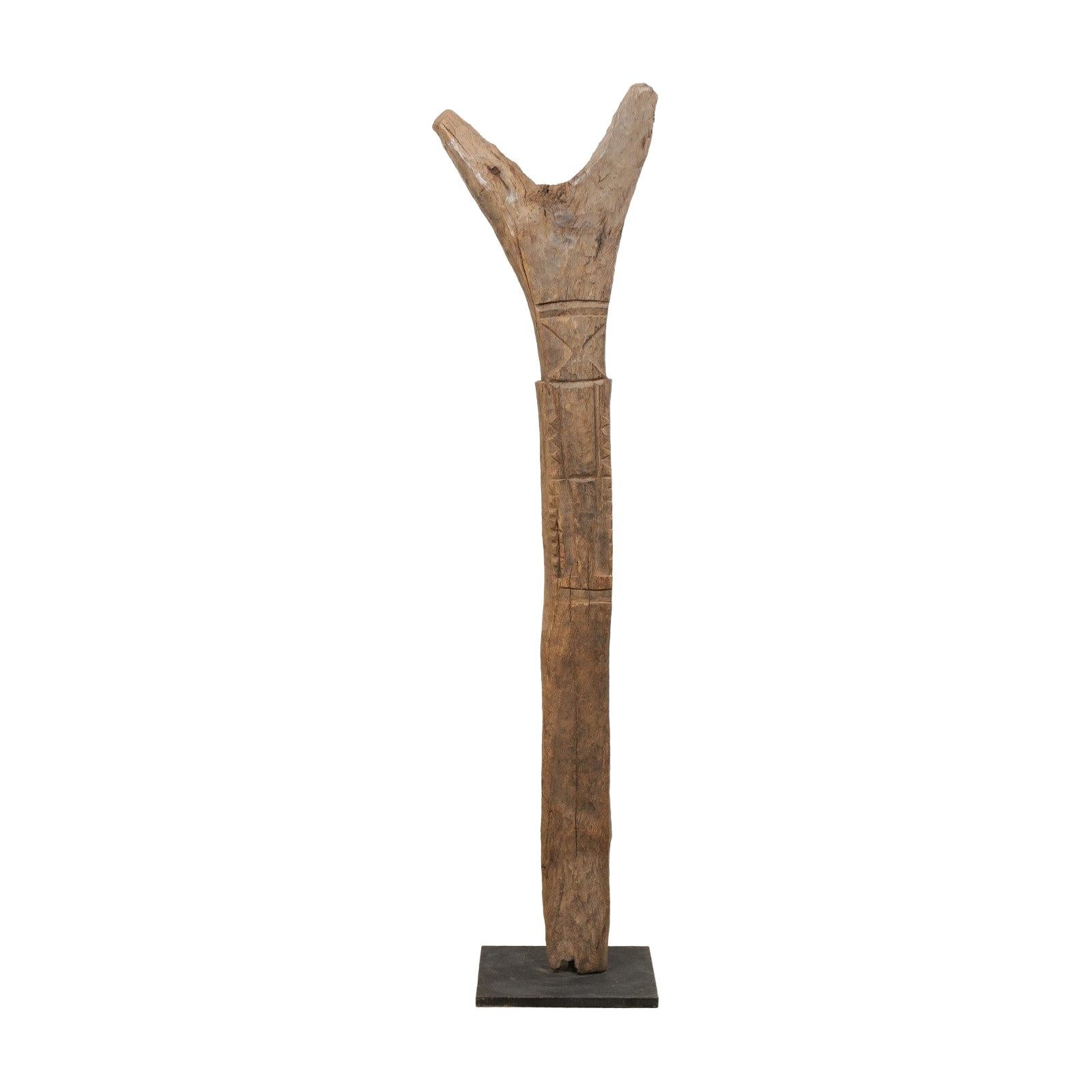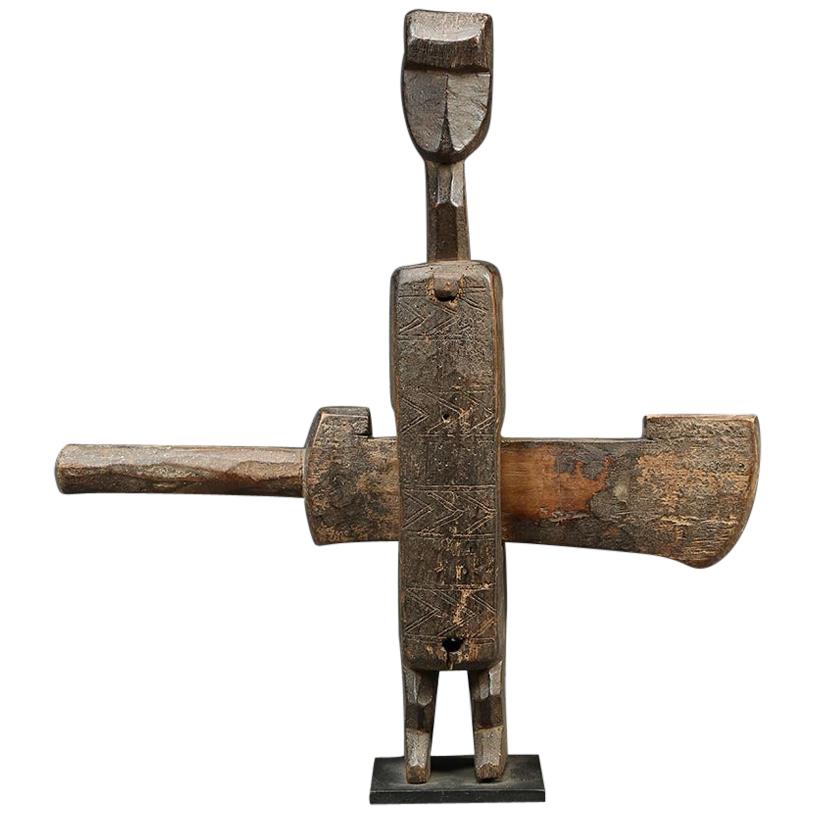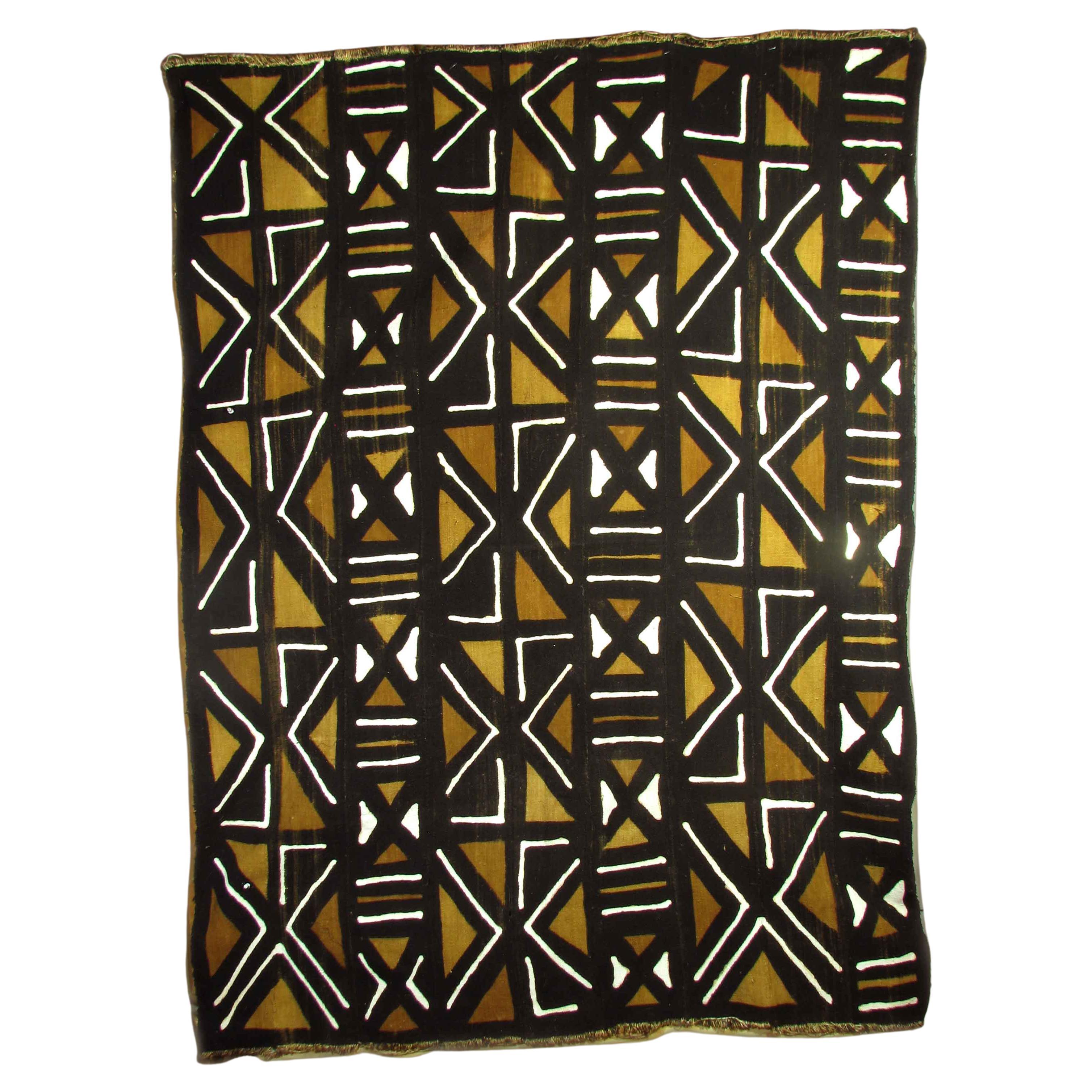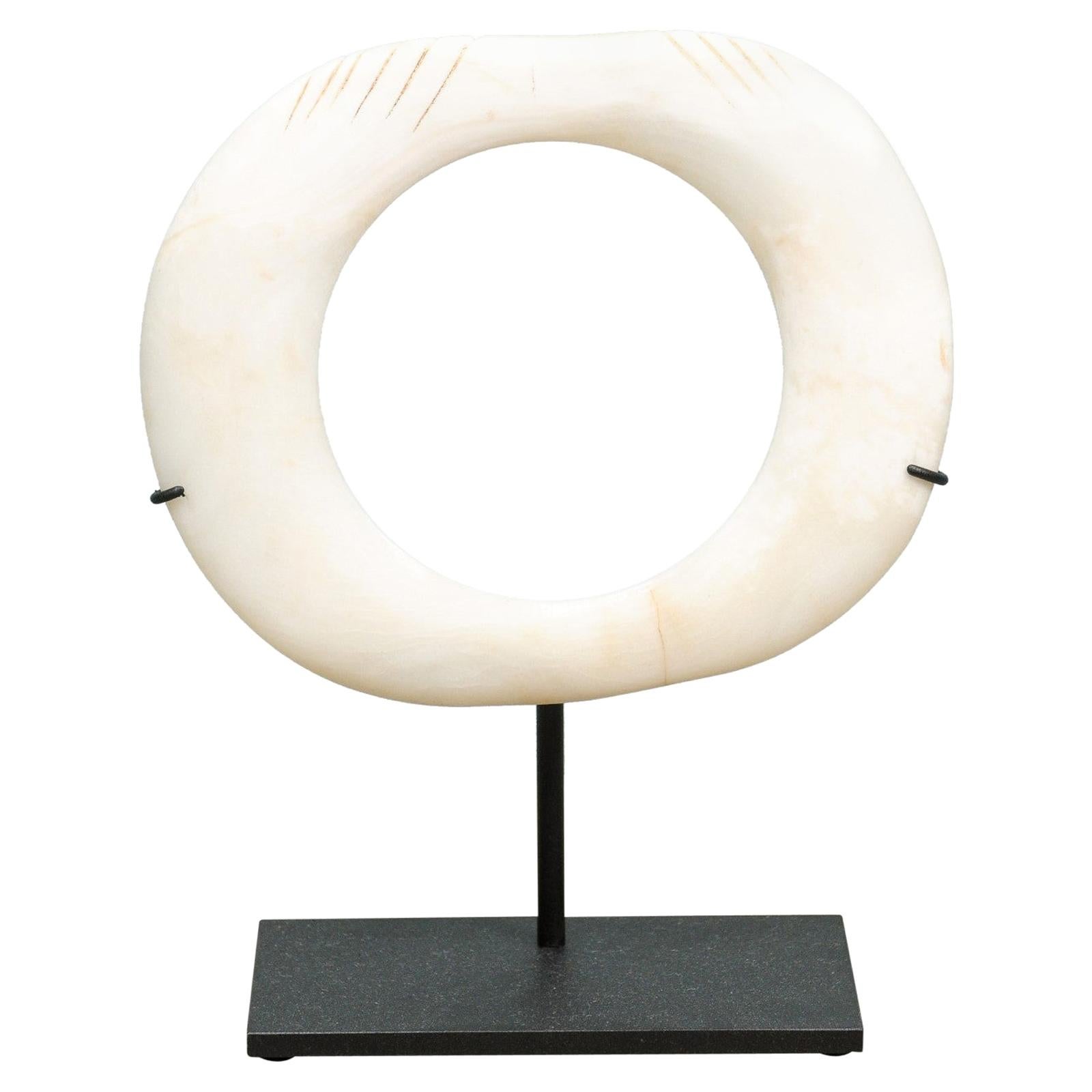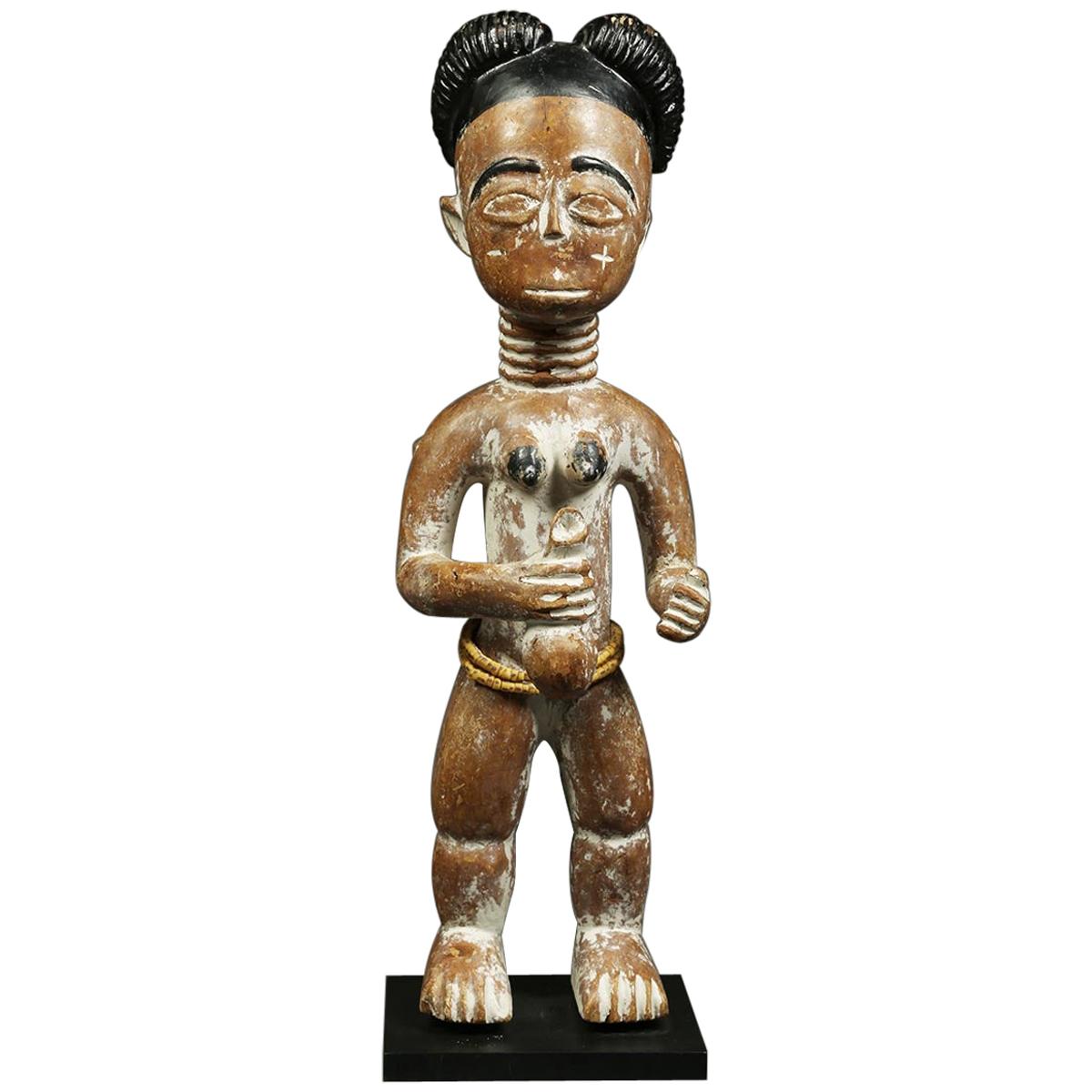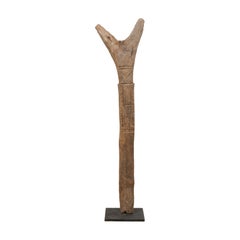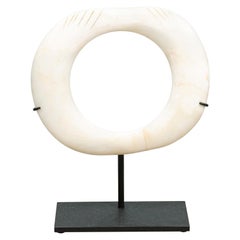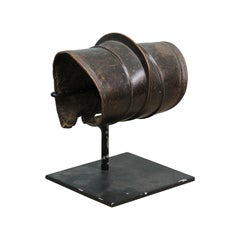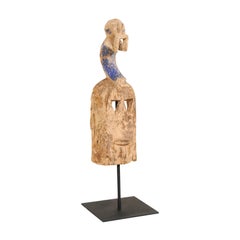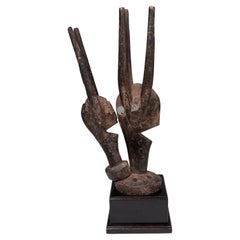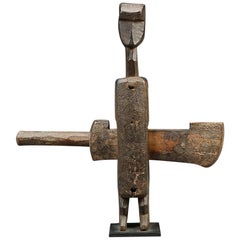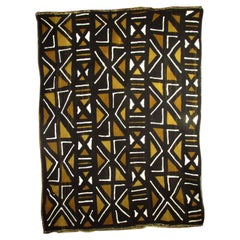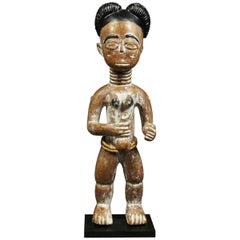Items Similar to Mid-20th Century Toguna Female Anthropomo Post from Mali
Want more images or videos?
Request additional images or videos from the seller
1 of 11
Mid-20th Century Toguna Female Anthropomo Post from Mali
About the Item
An early to mid-20th century Toguna support post from the Dogon Tribe of Mali, on custom metal stand. This West African hand carved wooden bean was originally used for supporting the "Toguna", a shelter were counsel members of the Dogon Tribe would assemble, whereas the lower portion would be buried beneath the ground and the typical "Y" shaped top would support the upper header beams (these buildings were designed to be low to the ground to take advantage of cooler temperatures and to help keep men from posturing during lively debates). This hand carved rustic wooden beam, with feminine carvings, has a lovely old patina. It has been prominently presented upright, as it would have been during it's use as the Toguna support post, upon a custom square-shaped iron base. This handsome architectural post from Mali, standing over 7 feet in height, would be a wonderful piece of African art displayed within a living room, study or entry hall.
- Dimensions:Height: 88.5 in (224.79 cm)Width: 17 in (43.18 cm)Depth: 12 in (30.48 cm)
- Materials and Techniques:
- Place of Origin:
- Period:
- Date of Manufacture:Mid-20th Century
- Condition:Wear consistent with age and use.
- Seller Location:Atlanta, GA
- Reference Number:Seller: Accessory #19971stDibs: LU876416079092
About the Seller
5.0
Platinum Seller
Premium sellers with a 4.7+ rating and 24-hour response times
Established in 1991
1stDibs seller since 2009
1,337 sales on 1stDibs
Typical response time: <1 hour
- ShippingRetrieving quote...Shipping from: Atlanta, GA
- Return Policy
Authenticity Guarantee
In the unlikely event there’s an issue with an item’s authenticity, contact us within 1 year for a full refund. DetailsMoney-Back Guarantee
If your item is not as described, is damaged in transit, or does not arrive, contact us within 7 days for a full refund. Details24-Hour Cancellation
You have a 24-hour grace period in which to reconsider your purchase, with no questions asked.Vetted Professional Sellers
Our world-class sellers must adhere to strict standards for service and quality, maintaining the integrity of our listings.Price-Match Guarantee
If you find that a seller listed the same item for a lower price elsewhere, we’ll match it.Trusted Global Delivery
Our best-in-class carrier network provides specialized shipping options worldwide, including custom delivery.More From This Seller
View AllA Dogon Tribe Toguna Post from Mali (Mid 20th C.) on Custom Iron Stand
Located in Atlanta, GA
An early to mid-20th century Toguna support post from the Dogon Tribe of Mali, on custom metal stand. This West African hand carved wooden bean was origin...
Category
Mid-20th Century Malian Mounted Objects
Materials
Iron
Single Yua Wenga Currency from the Early 20th Century
Located in Atlanta, GA
A single Yua Wenga currency from the early 20th century on custom iron stand. This antique tribal currency piece from Papua New Guinea has been carved ...
Category
Early 20th Century Papua New Guinean Natural Specimens
Materials
Bone
Copper Konga Legband from, Early 20th Century
Located in Atlanta, GA
An early 20th century (possibly late 19th century) African Legband (ankle bracelet) of copper alloy, from Mongo Peoples of the Congo. These legbands were both currency and status sym...
Category
Early 20th Century Congolese Tribal Art
Materials
Copper
Dogon Mali Carved Wood Ceremonial Mask, Early to Mid 20th Century
Located in Atlanta, GA
A Dogon Mali dance mask with carved figure from the early to mid 20th century. This Dogon tribal wooden ceremonial dance mask originates from Mali, West Afr...
Category
Mid-20th Century Malian Figurative Sculptures
Materials
Wood
Early 20th Century Belu "Female" Door from Timor Island
Located in Atlanta, GA
An early 20th century carved wood door panel from Timor Island in the Indonesian archipelago. This antique wall panel from Timor Island (an isl...
Category
20th Century Indonesian Tribal Mounted Objects
Materials
Metal
Kerala Spiral Carved-Wood Boat Prow from Southern India
Located in Atlanta, GA
A South Indian (Kerala) wooden boat prow from the mid-20th century. This hand carved boat prow from Kerala is adorn with pierced spiral-carved volute, suppor...
Category
20th Century Indian Tribal Art
Materials
Wood
You May Also Like
Early 20th Century Chiwara Headdress, Bamana 'Bambara' People, Mali
Located in Point Richmond, CA
Early 20th century Chiwara Headdress, Bamana (Bambara) People, Mali
Chiwara headcrests represent the antelope spirit who taught the Bamana people ...
Category
Early 20th Century Malian Tribal Mounted Objects
Materials
Wood
Fine Tribal Bambara Cubist Figurative Wood Door Lock Early 20th c Mali Africa
Located in Point Richmond, CA
Fine Tribal Bambara cubist figurative wood door lock, early 20th century Mali, Africa great abstract figure with strong cubist stylized elegant face.
The Bambara of Mali use decorated door locks sliding horizontal bar and with a removable key (missing here) to secure the doors to houses or millet granary. This door lock shows a stylized human body with strongly sculpted face and carved notch in back to hold the movable cross bar. The rectangular body is decorated with fine, geometric line...
Category
Early 20th Century Malian Tribal Tribal Art
Materials
Wood
$1,365 Sale Price
30% Off
Mud Cloth 'Bogolanfini', Mali, Bamana People, Mid-20th Century
Located in Ottawa, Ontario
A mud cloth (Bogolanfini),
Mali, Bamana People
mid-20th century.
Hand woven 'discharge dyed' cotton
Approximately 71 x 52 in. (180cm. x 132cm.)
A dazzling geometric pattern...
Category
Mid-20th Century Malian Tribal Tribal Art
Materials
Fabric
Standing Akan Ghana Tribal Female Figure Early 20th Century Africa, Black Hair
Located in Point Richmond, CA
Akan, Ghana, shrine figure, a standing female figure with black hair and details, remains of white pigment, with arms out holding a bottle, includes custom metal base. Probably a fig...
Category
Early 20th Century Ghanaian Tribal Tribal Art
Materials
Wood
$971 Sale Price
35% Off
Mid-20th Century Ceremonial Comb, Luba People, Zaire, D. R. Congo
Located in Point Richmond, CA
Ceremonial comb, Luba People, Zaire, D. R. Congo
Made of palm leaf midribs, this large, graphic comb has a pinched waist and is held together with finely wrapped wire. Presented o...
Category
Mid-20th Century Congolese Tribal Tribal Art
Materials
Wire
Bamana N'tomo mask, Mali, 20th century
Located in NICE, FR
Bamana N'tomo mask, Mali, 20th century
"Generally surmounted by three to eight horns forming a comb, the N'tomoface mask refers to a moment of compulsory education given to uncircumcised young boys in certain West African societies. The mask's discreet, even absent, mouth emphasizes the behavior expected of them in their future adult life after training: controlling and measuring their words, knowing how to keep quiet, preserving secrets and enduring pain in silence."
Excerpt from Masques du N'tomo, Marc Ladreit de Lacharrière Collection, Musée du Quai Branly Jacques Chirac, France.
The Bambara, or Bamana, live in central and southern Mali. Their name means “unbeliever” and was given to them by the Muslims. Animists, they believe in the existence of a creator god called Ngala, who maintains the order of the universe and coexists with another androgynous god called Faro, master of the Word, who gave all qualities to mankind and makes the fruits of the earth grow. Traditional Bamana art objects are closely linked to agrarian rites.
The Bamana dance these masks during initiation and circumcision ceremonies for young boys in the Ntomo society. The face, with its vertical outgrowths at the top, adopts geometric features beneath a rounded forehead, including an imposing busted nose, as the Bamana favor this organ in their statuary as it evokes sociability and clan cohesion. Indeed, during choreography, the dancer frequently touches the nose of the mask.
As teaching aids for candidates, masks from societies accessible to young boys and adults, such as the N'tomo, Korè and Ci wara...
Category
Vintage 1930s Malian Tribal Tribal Art
Materials
Wood
Recently Viewed
View AllMore Ways To Browse
Iron Post
Carved Wooden Post
Post And Beam Furniture
Carved Beam
Mali Africa
Mali Furniture
African Carved Female
African Iron Wood
Wood Beam Carved
Mali African Art
African Iron Sculpture
Wooden Coolers
Wooden Hand Carved Sculpture Of African
African Dogon
Mali Wood Sculpture
Dogon Mali
Vintage Wooden Cooler
Vintage Wooden Coolers
